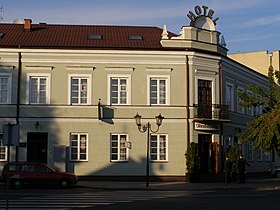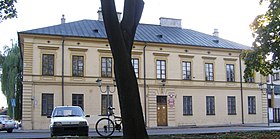Mińsk Mazowiecki
Name
The source of the town name Mińsk is the Mienia River, which in turn derives from the verb 'mienić', which means 'to shine'. The postnominal adjective 'Mazowiecki' shows the historical connection to Mazovia and distinguishes Mińsk Mazowiecki (English: “Masovian Minsk”) from the Belarusian capital of Minsk.
Location
Mińsk Mazowiecki is located historically in the region of Mazovia and administratively in the eastern part of Masovian Voivodeship, 37 kilometres (23 miles) east from Warsaw's Center and 20 kilometres (12 miles) from Warsaw's border.
History
The first mention of a settlement with commercial function comes from the 14th century. On 29 May 1421, Duke Janusz I of Warsaw from the Piast dynasty granted Mińsk town privileges. The first wooden church was built in 1422, however, it was not preserved. In 1549, the town of Sendomierz was located on the other side of Srebrna River. In 1629, the present church was opened. In 1695, Sendomierz was merged with Mińsk. The 18th century was a time of gradual decline of Mińsk connected with gradual decline of the Polish–Lithuanian Commonwealth.
Following the Third Partition of Poland, in 1795, the town was annexed by Austria. After the Polish victory in the Austro-Polish War of 1809, it became part of the short-lived Polish Duchy of Warsaw. After the duchy's dissolution, in 1815, it became part of Russian-controlled Congress Poland. During the November Uprising, it was the site of two battles between Polish insurgents and Russian troops, fought on 26 April and 14 July 1831.
In 1866, the Mińsk County was established, and the first train arrived to Mińsk (Warsaw–Terespol Railway). In 1867, the name of the town was changed to Nowomińsk (Novominsk). In 1870, the Dernałowicz Family became the last owners of the town (up to the Second World War). In 1886, the first bookstore in east Mazovia was founded in the town.
In 1910 or 1912, the Maria Grochowska's School was opened (present-day Polska Macierz Szkolna High School). In 1914, the old church was reopened after reconstruction, and the following year the present hospital was opened.

During World War I, it was occupied by Germany from 1915 to 1918. In 1916, the town was renamed to Mińsk Mazowiecki. In 1918, Poland regained independence and control of Mińsk. During the Polish–Soviet War, it was briefly occupied by the Russians on 16 August 1920, and then recaptured by the Poles the next day. On 18 August 1920 Marshal Józef Piłsudski stayed in the town. In the interbellum, the town enjoyed great development, and in 1937 the first electric train arrived. The 7th Lublin Uhlan Regiment was stationed in Mińsk Mazowiecki in the interbellum, and nowadays there is a museum dedicated to the unit in the town.
On 13 September 1939, it was the site of the Battle of Mińsk Mazowiecki between Poles led by General Władysław Anders and the invading German army. Afterwards it fell under German occupation. In 1939, some expelled Poles from Barcin, Kępno, Ostrzeszów, Rychtal and Szubin were deported to Mińsk Mazowiecki. In October 1940, the occupiers established the Mińsk Mazowiecki Ghetto, which was eventually liquidated on 21 July 1942, with most of the Jewish residents murdered at the Treblinka extermination camp in one of the first episodes of the Holocaust. Two Poles who were held by the Germans in the local prison for rescuing Jews were liberated by the Polish resistance. On 30 July 1944, Mińsk Mazowiecki was liberated by the Polish underground Home Army (prelude to the Warsaw Uprising), however, the Soviets occupied the town the next day. On 2–3 March 1945, the Soviets carried out executions of the local Polish elite, including Mayor Hipolit Konopka. After the war, the town was restored to Poland, although with a Soviet-installed communist regime, which stayed in power until the Fall of Communism in the 1980s.

In 1952, the ZNTK Mińsk Mazowiecki train construction factory was founded. In 1957, Mińsk Mazowiecki became a military garrison. A new train station was opened in 1979. Solidarity events took place in 1985. In 1990, Zbigniew Grzesiak was elected Mayor in first post-WWII free elections. In 1999, the Mińsk County was established.
Jewish history

In 1768, the restrictions on permanent residence for Jewish people in Mińsk had been lifted. From the 19th century to the 1930s, it became very popular. Before the Second World War, there were thousands of Jews living in Mińsk, and they had a general synagogue and smaller temples. The Novominsk hasidic dynasty was founded here in the late 19th century by Rabbi Yaakov Perlow, a descendant of the Baal Shem Tov.
Soon after the war began, the Germans created the Mińsk Ghetto. It was liquidated on 21 July 1942. Most of the Jews were murdered in Treblinka extermination camp sent in Holocaust trains by the thousands. The remaining Jewish population were murdered in Mińsk on 10 January 1943 (500 people) and 5 June (the last 150 people).










